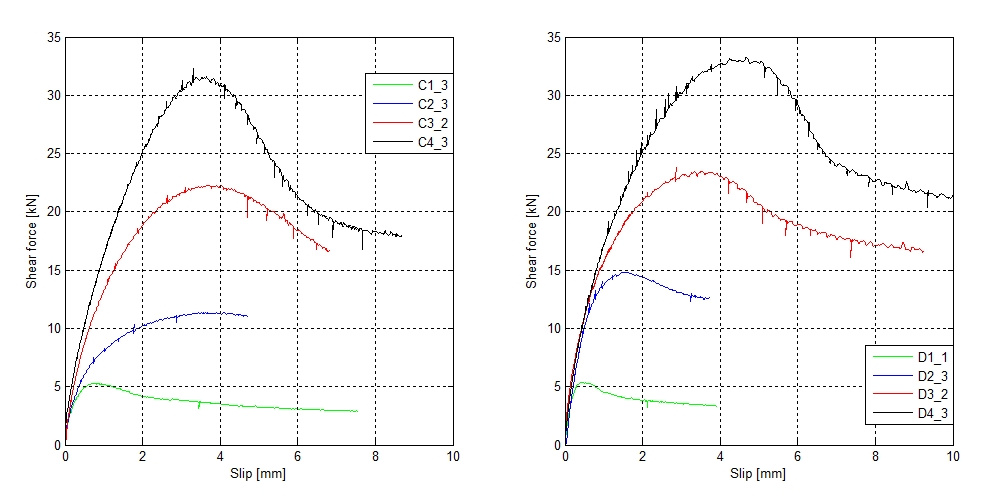Shear Strength Parameters of Masonry Elements with Damp-Proof Course Membrane
A research project on the shear behaviour of masonry elements (triplets) with damp-proof course (DPC) membrane placed in the bed joints is underway at the Institute of Structural Engineering of ETH Zurich. The main goal of the research project is to investigate the influence of DPC on masonry behaviour under shear and to assess the shear strength parameters: cohesion and friction coefficient.
Within the framework of the first phase of this project load tests on four series of masonry triplets have been performed. Each series consisted of 12 specimens with dimensions of either 290x250 mm (series A, B, C) or 230x250 mm (series D). The elements’ thickness was 120 mm. A standard cement mortar was used to produce 10 mm thick bed joints. A DPC elastomer-based membrane has been placed in each bed joint of the specimens of series B, C and D, whilst 12 specimens of series A were built without DPC and served as control specimens. The DPC was placed either in the middle of the bed joint (series B) or between the masonry unit and bed joint mortar (series C and D). The elements of all series were built using clay blocks, except for series D specimens where the outer units were concrete bricks, which were used in order to simulate the concrete slab. Twenty eight days after preparation the elements were firstly subjected to certain pre-compression and subsequently subjected to shear load that was applied in a deformation-controlled manner up to failure of the specimen. Four different levels of pre-compression were considered (0.2 MPa, 0.6 MPa, 1.0 MPa and 1.5 MPa) and for each level three replicates were tested for each series.
The results of the first phase of the project are presented in:
N. Mojsilovic, M. Krucker: "Shear Tests on Masonry Elements with Damp-Proof Course Membrane", Proceedings, 15th International Brick/Block Masonry Conference, Florianopolis, June 3-6, 2012, CD-ROM, Paper No. 7A3.
In the second phase of the research project a load tests on additional six series, E to K, of masonry elements with two additional damp-proof course membranes have been completed. For series E, F and G the bitumen-based DPC membrane has been applied and for the test series H, I and K a polyester-based DPC membrane has been chosen. The specimens dimensions and the placement of the DPC membrane were analogue to those of the series B, C and D. Also, same levels of the pre-compression were applied and for each level three replicates were tested for each series.

The analysis and discussion of the results of shear tests on all ten series (total of 120 specimens) of masonry elements with three different types of DPC allow following conclusions to be drawn:
- The shear strength of the specimens was highly influenced by the pre-compression level: the higher the pre-compression level, the higher the shear strength; except for the bitumen-based DPC where the shear strength was independent on pre-compression level. However, the position of the DPC had a negligible influence on the shear strength of the specimens.
- For the prediction of the failure shear force for masonry elements with elastomer- and polyester-based DPC a Mohr–Coulomb failure criterion with zero cohesion can be applied. However, for the specimens without DPC and with bitumen-based DPC cohesion must be taken into account.
- Due to sliding failure considerable energy dissipation and quasi ductile behaviour, i.e. a large deformation capacity could be expected in actual masonry structures with DPC placed in the bed joints. Such behaviour would be desirable for enhanced seismic performance. However, a zero friction coefficient found in specimens with bitumen-based DPC should be taken into account.
This research project has been supported by ZZ Wancor AG, Stauffer AG and Sika AG and this support is gratefully acknowledged. The findings of the presented research are summarized in the following publication:
N. Mojsilovic: "external page Masonry elements with damp-proof course membrane: Assessment of shear strength parameters", Construction and Building Materials, 35, 2012, pp. 1002-1012.
This project has been completed.
